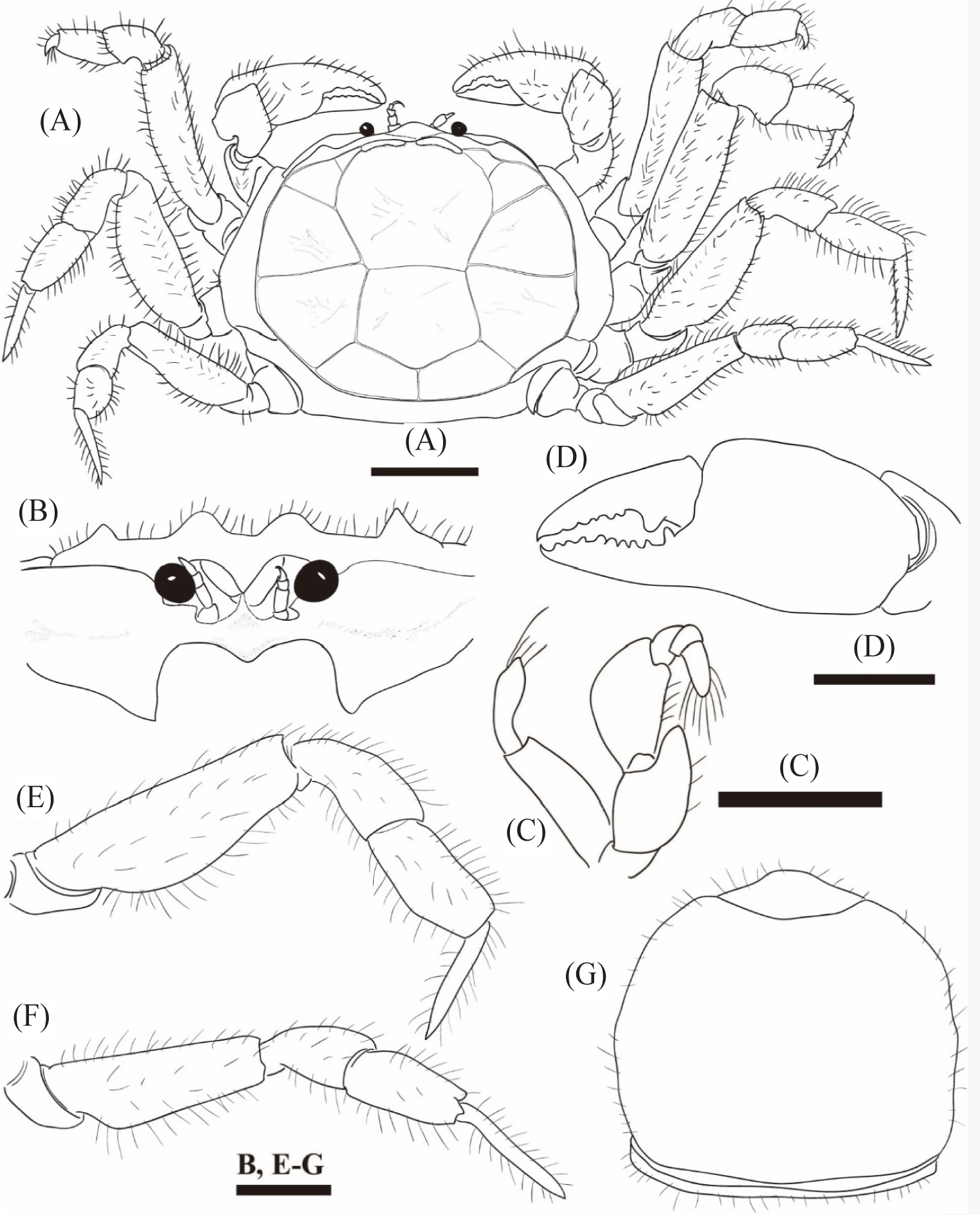Introduction
The genus Elamenopsis Milne-Edwards, 1872 is represented by six species worldwide: E. ariakensis (Sakai, 1969), E. comosa (Ng & Chuang, 1996), E. gracilipes (Rahayu & Ng, 2019), E. guinotae (Poore, 2010), E. lineata (Milne-Edwards, 1872), E. rotunda (Naruse & Ng, 2007) (Ng et al., 1999; Poore, 2010; Rahayu & Ng, 2019). The taxonomy of the genus Elamenopsis was currently established for Lucas (1980) and Ng & Chuang (1996). In Korean waters, however, Elamenopsis has not been reported so far.
The family Hymenosomatidae in Korean waters has been represented by six genera: Elamena (Milne-Edwards, 1834), Lucascinus (Poore et al., 2016), Neohymenicus (Lucas, 1981), Rhynchoplax (Stimpson, 1858), Stimpsoplax (Poore et al., 2016), Trigonoplax (Milne-Edwards, 1853) (Kim, 1973, 1985, 1992). Elamenopsis ariakensis is the only member of the genus Elamenopsis and seventh hymenosomatidae species known from South Korea. Elamenopsis ariakensis is generally known as commensal with holothurian, Protankyra bidentata (Woodwards & Barrett, 1858) (Kai & Henmi, 2008; Sakai, 1969). However, this species (E. ariakensis) was collected from a shelly sand/mud bottom at 50 m depth of Korean waters. Ng et al. (1999) and Kosuge et al. (2002) reported that E. ariakensis, collected from Fujian, China and Ariake Sea, Japan was free-living. In this article, we report E. ariakensis as a new record from Korean waters.
Specimens examined in this study have been deposited in the Korea Benthos Research Center (KOBE-104), Busan. Carapace length (CL) and carapace width (CW) in millimeters are used as the standard length of this specimen for measurements. Abbreviations P2-P5 are used for first to fourth ambulatory legs in the description.
Family Hymenosomatidae (MacLeay, 1838)
Genus ElamenopsisMilne-Edwards, 1872
Elamenopsis ariakensis (Sakai, 1969) (Figs. 1 and 2)


[Korean name: Dung-gun-mal-rang-ge]
Neorhynchoplax ariakensisSakai (1969: 250, figs. 2, 3a–d); Sakai (1976: 150, figs. 79, 80a–d, pl. 47, fig. 1).
Elamenopsis ariakensisLucas (1980: 159; in key); Ng et al. (1999: 85, fig. 3); Kosuge et al., 2002: 104, fig. 2); Naruse & Ng (2007: 122; in key); Kai & Henmi (2008: 347, fig. 5); Poore (2010: 266; in table); Maenosono (2017: 23, fig. 1); Rahayu & Ng (2019: 543; in key).
Korea: East China sea, 31°30’00˝N 125°17’06˝E, 50.0 m depth, van Veen grab sampler, August, 2022, 1 female (CL 3.1 × CW 3.9 mm) (KOBE-104).
Carapace (Figs. 1A, 2A, 2B) slightly convex, oval, about 1.25 times as wide as long; dorsal rim subcircular; dorsal surface of carapace with clear cut grooves and slightly concave; gastric region largest; anterolateral margin of carapace with 2 distinct teeth; rostrum unilobate and triangular and deflexed downwards; eyestalks very short; carapace covered with short hairs.
Third maxilliped (Fig. 2C) with merus longer than ischium along lateral edge (Fig. 2C).
Cheliped (Figs. 1, 2D) symmetrical; movable finger and immovable finger with small teeth on cutting edge; movable finger with large blunt tooth on proximal third of cutting edge.
Ambulatory legs (Figs. 1, 2A, 2E, 2F) dissimilar, covered with short hairs; P3 largest, P5 smallest; stout P2–P4 without teeth on the dactylus, P5 merus wide about 3.2 times as long as wide.
Abdomen (Figs. 1B, 2G) subpentagonal with 3-segmented including telson; 2–5 segment fused.
Shimabara, Nagasaki, Japan (Sakai, 1969); Ariake Sea, Japan (Kosuge et al., 2002); Ryukyu Islands, Japan (Maenosono, 2017); Fujian, China (Ng et al., 1999); now also from Korea (this study).
The holotype morphological characteristics of E. ariakensis were described by Sakai (1969). However, there was no comparison because it simply described the male. The present specimen at hand is female, but it agrees well with Ng et al. (1999) who reviewed the morphology of the E. ariakensis.
Rahayu & Ng (2019) provided a revised key to all Elamenopsis species. Of the six known species of Elamenopsis, E. ariakensis closely resembles E. rotunda in having the carapace teeth at the anterolateral margin and unilobate rostrum. However, E. ariakensis differs from E. rotunda in having the anterolateral margin of carapace with two distinct teeth. In E. rotunda, the anterolateral margin of carapace has one low tooth. In addition, E. ariakensis has relatively thick fourth ambulatory leg compared to E. rotunda. The merus of the fourth ambulatory leg of E. ariakensis is 3.2 times as long as broad, whereas that of E. rotunda is 3.8 times as long as broad.








